Two long parallel plates A and B are separated by a distance of 4 cm with an electric field of between the plates normally from plate A to plate B , as shown in the figure. An electron is projected from plate A with velocity v at an angle of with the surface of plate A . The maximum value of v so that the electron does not hit plate B is
(Assume gravity free space, charge of electron C and mass of electron kg )
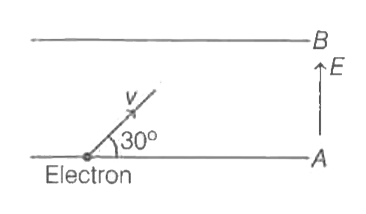 Solution in Telugu
Solution in Telugu
The correct Answer is:D
Given, electric field,
charge of electron
mass of electron , < br> According to the question,
Maximum height in a projectile motion,
()
force in electric field,
or
From Eqs. (i) and (ii), we get
Hence, the maximum value of v so that the electron does not hit plate b is 1600
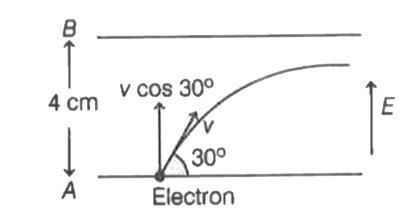
Topper's Solved these Questions
- AP EAMCET ENGINEERING ENTRANCE EXAM Book:TS EAMCET PREVIOUS YEAR PAPERSChapter:AP EAMCET ENGINEERING ENTRANCE EXAM Exercise:Physics
Explore 37 Videos
- AP EAMCET ENGINEERING ENTRANCE EXAM ONLINE QUESTION PAPER 2019 (SOLVED)Book:TS EAMCET PREVIOUS YEAR PAPERSChapter:AP EAMCET ENGINEERING ENTRANCE EXAM ONLINE QUESTION PAPER 2019 (SOLVED)Exercise:PHYSICS
Explore 39 Videos
Similar Questions
A car moving with a certain velocity jumps form an inclined plane placed at one bank of a river and reaches the other bank by attained a maximum height of 80 m if the same car moving with the same velocity jumps from another inclinded plane having different angle of inclination and reaches the same point on the other bank by attaining maxmimum height of 45 m then the width of the river is
View SolutionIF the charge of electron c , mass of electron m, speed of light in vaccum c and Planck's constant h are taken as fundamental quantities. Then the permeability of vaccum μ0 can be expressed as
View Solutionshows two metallic plates A and B placed
. parallel to each other at a separaton d. A uniform
. electric field E exists between the plates in the direction
. from plate B to plate A. Find the potential difference
. between the plates.
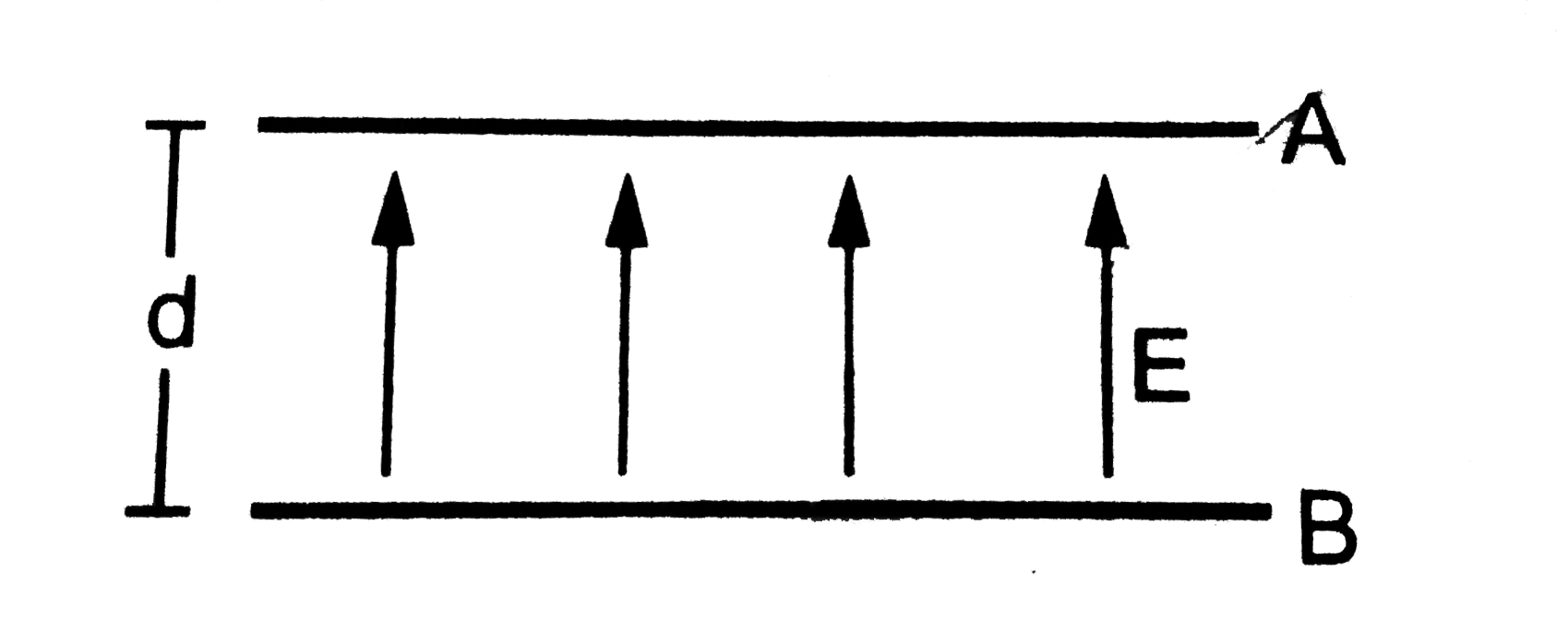
View SolutionAn electric field of magnitude 1000NC−1 is produced between two parallel platees having a separation of 2.0 cm as shown in figure(29.E4) (a) What is the potential difference between the plates? (b) With what minimum speed should an electron be projected from the lower plate in the direction of the field so that it may reach the upper plate? ( c) Suupose the electron is projected from the lower plate with the speed calculated in part (b) . The direction of projection makes an angle of 60∘ with the field. Find the mazimum height reached by the electron.

View SolutionAn electron enters the region between the plates of a parallel plate capacitor at an angle theta to the plates. The plate width is l , the plate separation is d . The electron follows the path shown just missing the upper plate. Neglect gravity. Then,
View SolutionA partical having charge that of an electron and mass 1.6xx10^(-30) kg is projected with an initial speed u at the angle 45^(@) to the horizontal from the lower plate of a parallel-plate capacitor as shown in fig. The plates are suffiecienly long and have a separation of 2 cm, find the maximum value of the velocity of he particle so that it does not hit the upper plate. Take the electric field between the plates as 10^(3)Vm^(-1) directed upward.
View SolutionTwo plates are at potentials -10 V and +30 V . If the separation between the plates be 2 cm . The electric filed between them is
View SolutionA potential difference of 500 V is applied across a paralle plate capacitor. The separation between the plates is 2×10−3m. The plates of the capacitor are vertical. An electron is projected vertically upwards between the plates with a velocity of 105m/a and it moves undeflected between the plates. The magnetic field acting perpendicular to the electric field has magnitude of
View SolutionThe potential difference between two parallel plates is 10^(4) V. If the plates are separated by 0.5 cm, the force on an electron between the plates is
View SolutionThe uniform electric field intensity between the two plates of a parallel plate capacitor is 1×103Vm−1 acting vertically upwards as shown in the figure.
The plates are sufficiently long and have separation 2 cm. A particle of negative charge 1μC and mass 2 g is projected at an angle 45∘ with the electric field from the lower plate with a velocity 'u' . The maximum velocity acquired by the particle , if it is not hit the upper plate is
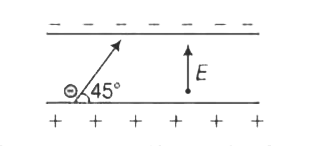
View SolutionTwo metal plates are separated by 2 cm. The potentials of the plates are -10 V and +30 V. The electric field between the two plates is
View SolutionThe distance between the plates of a parallel-plate capacitor is 0.05m. 3xx10^(4)V//m Area of is established. It is then separated from the battery and placed in a 0.01m thick uncovered metal plate between the capacitor plates. (a) Before inserting the metal plate and (b) after inserting the plate, remove the difference between the plates.
View Solutionदो समान्तर प्लेटों के विभव क्रमशः -10V एवं +30V हैं | यदि प्लेटों के बीच की दूरी 2cm हो | तो प्लेटों के मध्य विद्युत क्षेत्र होगा
View SolutionIn a parallel plate capacitor the potential difference of 100 V is manitianed between the plates. If distance between the plates be 5mm, what will be the electric field at points A and B ?
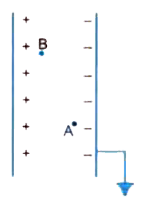
View SolutionAn electric field of magnitude 1000NC−1 is produced between two parallel platees having a separation of 2.0 cm as shown in figure(29.E4) (a) What is the potential difference between the plates? (b) With what minimum speed should an electron be projected from the lower plate in the direction of the field so that it may reach the upper plate? ( c) Suupose the electron is projected from the lower plate with the speed calculated in part (b) . The direction of projection makes an angle of 60∘ with the field. Find the mazimum height reached by the electron.

View Solution